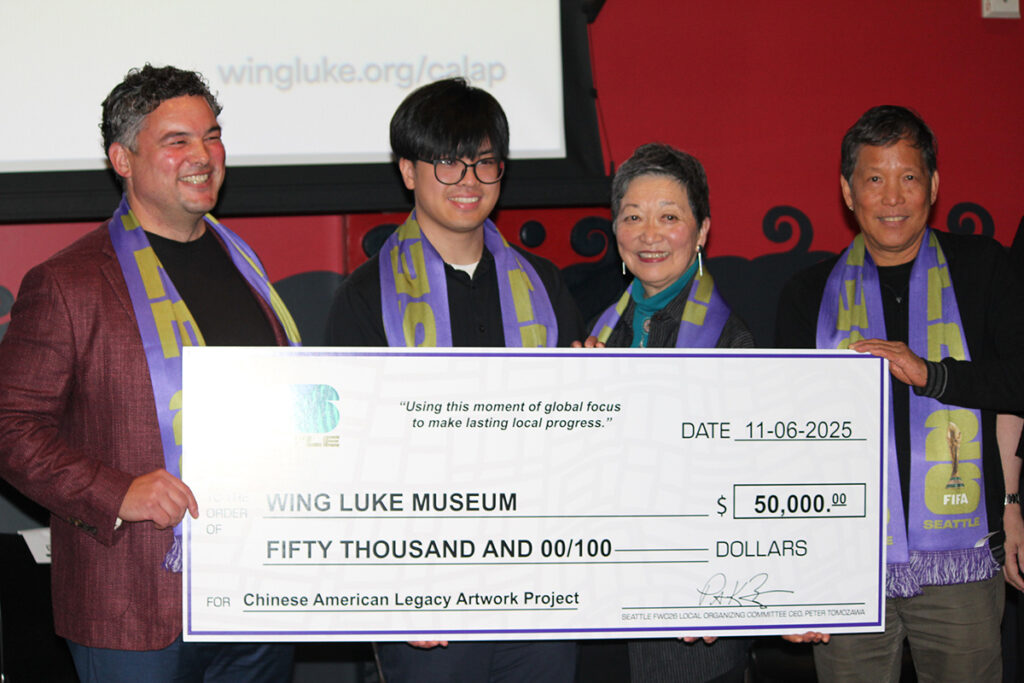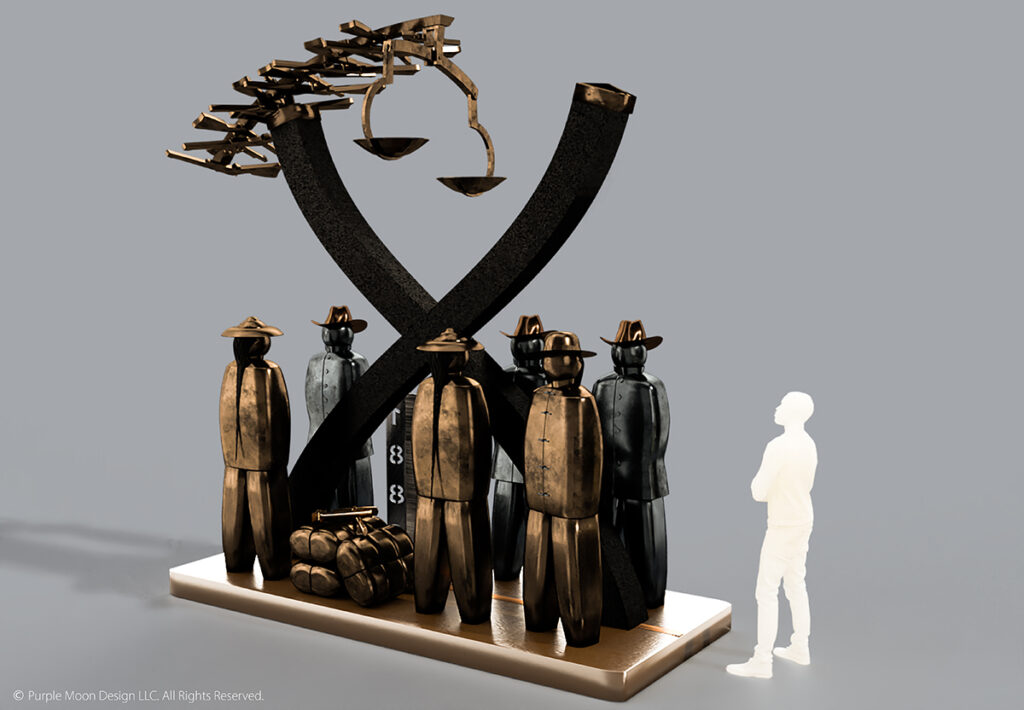By James Tabafunda
NORTHWEST ASIAN WEEKLY

(From left): Leo Flor, Dylan Hartono, Diane Sugimura, and Stewart Wong hold the $50,000 check from SeattleFWC26.
One hundred forty years after Seattle’s Chinese community was violently expelled, a new monument is finally in the works—with a $50,000 boost from the Seattle FIFA World Cup 26 Local Organizing Committee (SeattleFWC26).
The donation to the Wing Luke Museum’s Chinese American Legacy Artwork Project (CALAP) on Nov. 6 has advanced fundraising to approximately 60% of the project’s $500,000 target.
“Having heard from the artist, it’s even more clear to me that we’re doing the right thing by supporting this project,” said Leo Flor, chief legacy officer for SeattleFWC26, during a news conference at the museum’s Community Hall. “When hundreds of thousands of visitors, hundreds of millions of viewers are going to have their eyes on our city as it sparkles in the June and July sun … our mission is to use the attention, the excitement, and the possibility that come with having the world visit our city and convert that into lasting benefit for local priorities.”
Historical context
The project commemorates the Feb. 7, 1886 expulsion when a mob of approximately 1,500 people entered Seattle’s Chinese settlement, loaded residents onto wagons, and transferred them to the waterfront, where 196 people boarded the steamship Queen of the Pacific.
The violent expulsion occurred four years after Congress passed the Chinese Exclusion Act of 1882, the first federal law barring immigration based on race or nationality. The law prohibited Chinese from entering the United States for 10 years and denied citizenship to those already in the country.
“The riot is one of the darkest days that Seattle’s history has experienced with the anti-Chinese movement,” said Dylan Hartono, a member of the CALAP’s governing committee. “There was a broad campaign to get the Chinese out of America.”
Seattle Mayor Bruce Harrell, who attended the donation ceremony, acknowledged the historical significance while drawing parallels to contemporary challenges facing immigrant communities.
“This is a similar theme that we see even today,” he said, noting that the expulsion “makes today particularly meaningful.” He stressed that Seattle’s strength lies in its ability to confront historical truths. “We don’t run from it,” Harrell said. “In fact, we want others to know how we got to where we are because of our resilience and faith or belief in one another, our advocacy.”
City and community support
The City of Seattle committed $30,000 through a Department of Neighborhoods grant to support the project.
“It didn’t cost us anything,” Harrell said. “The reason I say that is this is an investment. The dividends will pay off incredibly well for everyone that will participate.”
“As we prepare for the world to see us for the World Cup next year, we have a powerful opportunity not just to host the games, but to really tell our stories, what our culture is,” he said, emphasizing the Chinatown-International District (CID)’s role in Seattle’s story of resilience.
Public art design and timeline

Image provided by Wing Luke Museum
The CALAP commissioned Stewart Wong to design “Exclusion, Expulsion, Expunge,” a bronze and stainless-steel sculpture measuring 14 feet high, 12 feet long, and 6 feet wide and featuring six life-sized figures—three mob figures on one side and three Chinese laborers on the other side. At its center, a large stainless-steel X symbolizes displacement and division. A tipped Scale of Justice above the X represents the imbalance of law and protection.
“The biggest challenge for me is to create an impactful art installation considering the importance of this historical event that still resonates with what is happening politically today,” Wong said. He stressed the need to create a visual narrative around an event often forgotten or overlooked.
The mixed-media artist explained the sculpture’s intended intellectual and emotional impact on viewers. “The sculptural, tactile installation shall serve as a reminder this could happen to anyone,” Wong said, noting the work would provoke thoughts on racism, exclusion, inequities, deportation, and bullying.
Wong said fabrication cannot begin until full funding is secured. Once funded, fabrication and installation would require about one year, potentially allowing for dedication in late 2026 or early 2027, aligning with the expulsion’s 140th anniversary.
Museum and community response
Diane Sugimura, vice president of the Wing Luke Museum’s Board of Trustees and former director of the city’s Department of Planning and Development, accepted the donation on behalf of the museum.
“This is an amazing show of support for untold stories of the immigrants. They endured colonialism, racism, segregation, expulsion right here at our front door.” she said. “It all happened. And as speakers have said, sadly, it’s still an issue today and something that we need to remember.”
She recognized early supporters who spoke about creating a permanent memorial to the 1886 expulsion, including Bettie Luke, a retired teacher and community advocate.
“I want to thank Auntie Bettie Luke and the many community leaders who led the march in 1986 marking the 100th anniversary of that horrendous act,” she said, adding that Wing Luke, the museum’s namesake and the first Asian American elected to public office in the Pacific Northwest, would have approved of the project’s creation.
World Cup legacy vision
Flor characterized the donation as a part of SeattleFWC26’s broader mission to harness international attention surrounding the 2026 World Cup as a catalyst for lasting community benefit. The committee expects around 750,000 visitors during the event, which features six World Cup matches between June 15 and July 6, 2026.
The chief legacy officer linked the sculpture to the Unity Loop, a 4.25-mile walking trail stretching from Lumen Field through Seattle’s waterfront, Westlake Park, Occidental Square, and the CID. The trail, which will open before the 2026 World Cup and remain as a permanent fixture, will showcase the sculpture for decades.
“Stewart has described a thing that I can’t wait to see on the future Unity Loop that we’re building, and it’s going to last decades and teach the lessons, invite the reflection that we have heard here described for generations to come,” Flor said.
He emphasized that the committee’s role was not to dominate the narrative of community initiatives but instead to support existing advocates and creators.
“One thing I do want to say I disagree with you on one thing, Stewart, which is we too often honor the funders instead of the fighters and the artists and the people who create and propose the projects,” Flor said, adding that he believed the true heroes were the project’s original visionaries.
He made a direct fundraising appeal to the broader community. “We want you to join our team and make a donation that at least matches what our local organizing committee has contributed to this project. Let’s fund Stewart’s work. Let’s fund Auntie Bettie’s vision, and let’s get this thing built,” Flor said. “This is the first of these types of partnerships that we’ve announced leading up to the World Cup, but it’s not the last.”
He added that SeattleFWC26 is developing support plans for the Central District, Capitol Hill, Pioneer Square, and SODO (South of Downtown). “This, to me, is just a really powerful example of what a sports event can do to be more than sports and really be about community,” he said.
Historical acknowledgement
In 2015, the Seattle City Council unanimously approved Resolution 31605, expressing regret for anti-Chinese legislation passed by the Washington Territory and previous Seattle City Councils in the 1800s. Former Councilmember Nick Licata sponsored the resolution at the request of the Greater Seattle Chapter of the OCA Asian Pacific American Advocates and the local chapter of the Chinese American Citizens Alliance.
Wong referenced Licata’s work during the press conference. “Councilmember Nick Licata, who sponsored the city’s anti-Chinese resolution expressing regret, once said we shouldn’t bury our history. Discriminatory policies ripple from the past and still affect Chinese communities today. Awareness and recognition of shameful policies in our history is the first step to moving forward together,” the artist said.
Hartono emphasized the installation’s contemporary relevance. “It draws parallels towards what is happening today with exclusion,” he said, emphasizing Seattle’s responsibility to maintain inclusive values. “We don’t want that in Seattle. It’s an inclusive city where there’s diversity, and we see a lot of people coming from different backgrounds, the way they look and the way that they think.”
The CALAP is seeking additional donations to reach its fundraising goal. Contributions can be made through the Wing Luke Museum, which serves as the project’s fiscal sponsor.
Hartono concluded his remarks by expressing the project’s significance. “This incident has to be known. It’s part of recognition of the sacrifice and hardships we went through and the struggles we continue to face.”
For more information on the Chinese American Legacy Artwork Project, go to www.wingluke.org/calap.



